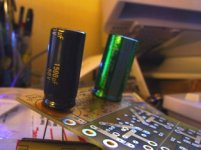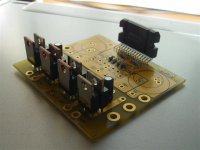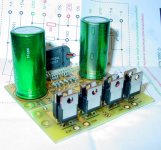For one thing I think the 3875 sounds slightly better than the 3886. Not much in it though, just as there isn't much in the power difference 😉
Lm3875
The LM3875 is about 56watts per channel The LM4780 or is it 4870? thats 60w/ch. If you run it in a parallel config, it goes up to about 100w/ch i think.
I don't know the difference in sound quality as I've yet to get my new amp going.
But the 3875's sound nice.
The LM3875 is about 56watts per channel The LM4780 or is it 4870? thats 60w/ch. If you run it in a parallel config, it goes up to about 100w/ch i think.
I don't know the difference in sound quality as I've yet to get my new amp going.
But the 3875's sound nice.
Re: Re: Daniel
3875 seems to have lower current output pairs, not as suitable for lower impedance speakers. It also lacks the mute that 3876 has.
4780 is two 3886 die in the same chip package.
raromachine said:Ah I see - no 3886 though, am I right in thinking that the 3875 is less powerful? I can't really see a difference. Will look at the datasheet tonight.
3875 seems to have lower current output pairs, not as suitable for lower impedance speakers. It also lacks the mute that 3876 has.
4780 is two 3886 die in the same chip package.
! said:3875 seems to have lower current output pairs, not as suitable for lower impedance speakers.
Ah yes - that was why I discounted it - alas. I guess it's a pity the whole family of chips isn't pin compatible.
Boards:- raromachine
I have some nice boards from audiosector. They are the nice gold ones, I think its the premium set.
I will not be building another set as I have plans to tackle something else after this current one I'm on.
You could get the non insulated LM3875 chips from RS. I've used them, they are o.k. I didn't even bother to put in any pads to insulate them on the heatsinks as my case was made from perspex. They are still going strong with no problems.
I have some nice boards from audiosector. They are the nice gold ones, I think its the premium set.
I will not be building another set as I have plans to tackle something else after this current one I'm on.
You could get the non insulated LM3875 chips from RS. I've used them, they are o.k. I didn't even bother to put in any pads to insulate them on the heatsinks as my case was made from perspex. They are still going strong with no problems.
Re: Boards:- raromachine
Again, I think the diff between the boutique bits and the good bits (basically the resistors and gold pcb?) will be lost on me.
~At $16 each (I think?) though... it (scarily) works out cheaper to buy all of the parts from Digikey.com and have them shipped over (assuming about $18US shipping) - BUT cheaper again if all the parts are shipped from one location 🙂
As an example (and I'm not arguing that the cost is unfair or unjustified, just that the 3886 kit suits my needs better):
Audio Sector
LM4780 Dual Mono Kit $73.00
Shipping $11.00
84 USD in NZD = $134.72 + currency conversion fees.
ChipAmp
Non-Inverting LM3886 Stereo Kit $60
Shipping $11
71 USD in NZD = $113.87 + currency conversion fees.
See! Maths is usefull for something 😀
enzedone said:I have some nice boards from audiosector. They are the nice gold ones, I think its the premium set.
Again, I think the diff between the boutique bits and the good bits (basically the resistors and gold pcb?) will be lost on me.
You could get the non insulated LM3875 chips from RS...
~At $16 each (I think?) though... it (scarily) works out cheaper to buy all of the parts from Digikey.com and have them shipped over (assuming about $18US shipping) - BUT cheaper again if all the parts are shipped from one location 🙂
As an example (and I'm not arguing that the cost is unfair or unjustified, just that the 3886 kit suits my needs better):
Audio Sector
LM4780 Dual Mono Kit $73.00
Shipping $11.00
84 USD in NZD = $134.72 + currency conversion fees.
ChipAmp
Non-Inverting LM3886 Stereo Kit $60
Shipping $11
71 USD in NZD = $113.87 + currency conversion fees.
See! Maths is usefull for something 😀
Prices
Yes you are right, sometimes its just cheaper to buy the kit. I got boards last time as I was lucky enough to some free sample chips.
So saved there.
It's that dam postage that gets us, down here.
Let me know how you get on. If you ever need to buy a couple of things to justify the postage drop me a line and maybe we can share the cost, to help bring things down.........
Brett
Yes you are right, sometimes its just cheaper to buy the kit. I got boards last time as I was lucky enough to some free sample chips.
So saved there.
It's that dam postage that gets us, down here.
Let me know how you get on. If you ever need to buy a couple of things to justify the postage drop me a line and maybe we can share the cost, to help bring things down.........
Brett
I think I've figured something out 🙂
The LM4780 is 2x 3886's and can be built in a such as way as to give 2 channels (stereo) - duh 🙂 I like this as the footprint is a little smaller.
The bang for buck isn't bad, and I have a source of 4780 chips which is well priced 🙂
I was going to use the Audio Sector kit - http://www.audiosector.com/lm4780.shtml - which I'm figuring means I could build two lower power amps?
So can anyone tell me how big the caps (1500uf ) on the power rails should be? Can they go up to say 2200uf or 3300uf? What's the size limitation (diameter in mm)?
Thx 🙂
The LM4780 is 2x 3886's and can be built in a such as way as to give 2 channels (stereo) - duh 🙂 I like this as the footprint is a little smaller.
The bang for buck isn't bad, and I have a source of 4780 chips which is well priced 🙂
I was going to use the Audio Sector kit - http://www.audiosector.com/lm4780.shtml - which I'm figuring means I could build two lower power amps?
So can anyone tell me how big the caps (1500uf ) on the power rails should be? Can they go up to say 2200uf or 3300uf? What's the size limitation (diameter in mm)?
Thx 🙂
That's what I meant when I mentioned it's two die in one chip package. It is nice for some applications, but then again, having separate chips means it may be easier to cool them, and separate chips means less cross channel power rail modulation, and easier to get more local decoupling with two chips. That is thinking about all possible design decisions though, in a pre-made board it's take-what-you-can-get, but even so, it would tend to be same situation inherantly when comparing a dual vs one channel chip.raromachine said:I think I've figured something out 🙂
The LM4780 is 2x 3886's and can be built in a such as way as to give 2 channels (stereo) - duh 🙂 I like this as the footprint is a little smaller.
! said:That's what I meant when I mentioned it's two die in one chip package...
I think I saw the first two circuit diagrams in the datasheet were bridge and parallel and thought that it wasn't for me!
! said:... It is nice for some applications, but then again, having separate chips means it may be easier to cool them, and separate chips means less cross channel power rail modulation, and easier to get more local decoupling with two chips. That is thinking about all possible design decisions though, in a pre-made board it's take-what-you-can-get, but even so, it would tend to be same situation inherantly when comparing a dual vs one channel chip.
In a way it means I need to understand more about the circuit and how to resolve them - more fun perhaps? 😀
Off the the sheet metal dealers on Monday...
edit: Can anyone point me something that explains capacitor ripple current?
Gainclone'd
So I went nuts, and ordered a 4780 kit from Audiosector (thanks Peter) which I plan to turn into two lower power stereo amps.
I have one small question, it might turn out to be opinion of science though:
I've got the 1500uf caps that come with the kit, and I've got some nice pretty green Nichicon FX 3300uf caps. Without starting a flame war - which should I use? (in peoples humble opinions).
I know the FC is a quality cap, and the Nichicon is possibly slightly less the flavour of the month.
So I went nuts, and ordered a 4780 kit from Audiosector (thanks Peter) which I plan to turn into two lower power stereo amps.
I have one small question, it might turn out to be opinion of science though:
I've got the 1500uf caps that come with the kit, and I've got some nice pretty green Nichicon FX 3300uf caps. Without starting a flame war - which should I use? (in peoples humble opinions).
I know the FC is a quality cap, and the Nichicon is possibly slightly less the flavour of the month.
Attachments
Would it help to suggest that one might offer a better top end and the other a better bottom end? <deleting...personal bias opinions>
lndm said:Would it help to suggest that one might offer a better top end and the other a better bottom end? <deleting...personal bias opinions>
Hrm, not sure, which one will tone my upper and lower abdominal muscles too? 😛
I think I could guess at which is resonsible for which 🙂
Various people say that a bigger cap doesn't really help the bass, although you would think so.
A great opportunity to make one each way and compare. Then swop out the one you don't like as much.
A great opportunity to make one each way and compare. Then swop out the one you don't like as much.
So, here's progress.
I'm not quite sure what the LED and RLED on the power supply stage should be the figuring I'm doing gives me.
VS = 18VAC * 1.414 = 25.452VDC
LED If = 50ma
LED Vf = ~2v
R = (Vs - Vf)/If = (25-2)/.03 = ~800.
Yet the info sheet with the kit gives 62K?
Eek?
I'm not quite sure what the LED and RLED on the power supply stage should be the figuring I'm doing gives me.
VS = 18VAC * 1.414 = 25.452VDC
LED If = 50ma
LED Vf = ~2v
R = (Vs - Vf)/If = (25-2)/.03 = ~800.
Yet the info sheet with the kit gives 62K?
Eek?
Attachments
There may not be much point in running a common LED (if that's what you have) at much more than 10mA. It may just be an 'ambience' thing to run it so lean.
Try 3 -5 ma
Most LED's at 50 ma will blind you, plus die rather quickly. I used to run mine at 5 -10 ma, and use ultrabrites. Now I use diffused, and run them at half the current used before. Still lights a room at night.
George
Most LED's at 50 ma will blind you, plus die rather quickly. I used to run mine at 5 -10 ma, and use ultrabrites. Now I use diffused, and run them at half the current used before. Still lights a room at night.
George
Bright LEDs are tight! 😀 They look cool on amps. I think that anything above 1000 mcd is bright.
2¢
2¢

- Status
- Not open for further replies.
- Home
- Amplifiers
- Chip Amps
- Do I really need/want a Gainclone?


